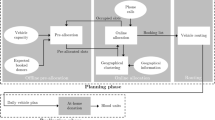Abstract
Blood is a key resource in all health care systems, usually drawn from voluntary donors. We focus on the operations management in blood collection centers, which is a key step to guarantee an adequate blood supply and a good quality of service to donors, by addressing the so-called Blood Donation Appointment Scheduling problem. Its goal is to employ appointment scheduling to balance the production of blood units between days, in order to provide a reasonably constant supply to transfusion centers and hospitals, and reduce non-alignments between physicians’ working times and donor arrivals at the collection center. We consider a two-phase solution framework taken from the literature, in which a deterministic linear programming model preallocates time slots to different blood types and a prioritization policy assigns the preallocated slots to the donors when they make a reservation. However, the problem is stochastic in nature and requires consideration of the uncertain arrivals of non-booked donors. In this work, to include the uncertain arrivals, we propose three stochastic counterparts of the preallocation model based on a risk-neutral objective and two risk-averse objectives, respectively, where the Conditional Value-at-Risk is considered as the risk measure in the last two methods. The resulting stochastic frameworks have been tested considering the historical data of one of the largest Italian collection centers, the Milan Department of the “Associazione Volontari Italiani Sangue” (AVIS). Results show the effectiveness of the stochastic models, especially the mean-risk one, and the need to include the uncertainty of arrivals in order to better balance the production of blood units.








Similar content being viewed by others
References
Attari MYN, Pasandide SHR, Agaie A, Niaki STA (2017) Presenting a stochastic multi choice goal programming model for reducing wastages and shortages of blood products at hospitals. Int J Ind Syst Eng 10(special issue on healthcare):81–96
Ayer T, Zhang C, Zeng C, White III CC, Joseph VR (2019) Analysis and improvement of blood collection operations: winner—2017 M&SOM practice-based research competition. Manufacturing & Service Operations Management 21(1):29–46
Ayer T, Zhang C, Zeng C, White III CC, Joseph VR, Deck M, Lee K, Moroney D, Ozkaynak Z (2018) American red cross uses analytics-based methods to improve blood-collection operations. Interfaces 48(1):24–34
Baş S, Carello G, Lanzarone E, Ocak Z, Yalçındağ S (2016) Management of blood donation system: literature review and research perspectives. Springer, Berlin, pp 121–132
Baş S, Carello G, Lanzarone E, Yalçındağ S (2018) An appointment scheduling framework to balance the production of blood units from donation. Eur J Oper Res 265(3):1124–1143
Baş Güre S, Carello G, Lanzarone E, Yalçındağ S (2018) Unaddressed problems and research perspectives in scheduling blood collection from donors. Prod Plan Control 29(1):84–90
Birge JR, Louveaux F (2011) Introduction to stochastic programming. Springer Science & Business Media
Blake J, McTaggart K (2016) Using simulation for strategic blood supply chain design in the canadian prairies. In: 2016 6Th international conference on simulation and modeling methodologies, technologies and applications (SIMULTECH). IEEE, pp 1–8
Chan TC, Mahmoudzadeh H, Purdie TG (2014) A robust-cvar optimization approach with application to breast cancer therapy. Eur J Oper Res 238(3):876–885
Dillon M, Oliveira F, Abbasi B (2017) A two-stage stochastic programming model for inventory management in the blood supply chain. Int J Prod Econ 187:27–41
Ensafian H, Yaghoubi S (2017) Robust optimization model for integrated procurement, production and distribution in platelet supply chain. Transportation Research Part E: Logistics and Transportation Review 103:32–55
Ensafian H, Yaghoubi S, Yazdi MM (2017) Raising quality and safety of platelet transfusion services in a patient-based integrated supply chain under uncertainty. Comput Chem Eng 106:355–372
Fazli-Khalaf M, Khalilpourazari S, Mohammadi M (2017) Mixed robust possibilistic flexible chance constraint optimization model for emergency blood supply chain network design. Ann. Oper. Res., 1–31
Gunpinar S, Centeno G (2015) Stochastic integer programming models for reducing wastages and shortages of blood products at hospitals. Comput Oper Res 54:129–141
Guo Y, Wood J, Pan W, Meng Q (2018) Inventory optimization of airport perishable emergency supplies with replacement strategy facing stochastic occurrence time by cvar approach. Int J Disast Risk Re 31:170–183
Hamdan B, Diabat A (2019) A two-stage multi-echelon stochastic blood supply chain problem. Comput Oper Res 101:130–143
Hemmelmayr V, Doerner KF, Hartl RF, Savelsbergh MW (2010) Vendor managed inventory for environments with stochastic product usage. Eur J Oper Res 202(3):686–695
Jabbarzadeh A, Fahimnia B, Seuring S (2014) Dynamic supply chain network design for the supply of blood in disasters: a robust model with real world application. Transportation Research Part E: Logistics and Transportation Review 70:225–244
Jafarkhan F, Yaghoubi S (2018) An efficient solution method for the flexible and robust inventory-routing of red blood cells. Comput Ind Eng 117:191–206
Kazemi SM, Rabbani M, Tavakkoli-Moghaddam R, Shahreza FA (2017) Blood inventory-routing problem under uncertainty. J Intell Fuzzy Syst 32(1):467–481
Markowitz H (1952) Portfolio selection. The journal of finance 7(1):77–91
Meloni C, Pranzo M (2019) Expected shortfall for the makespan in activity networks under imperfect information. Flex Serv Manuf J, pp 1–25
Najafi M, Ahmadi A, Zolfagharinia H (2017) Blood inventory management in hospitals: considering supply and demand uncertainty and blood transshipment possibility. Operations Research for Health Care 15:43–56
Noyan N (2010) Alternate risk measures for emergency medical service system design. Ann Oper Res 181(1):559–589
Osorio AF, Brailsford SC, Smith HK (2015) A structured review of quantitative models in the blood supply chain: a taxonomic framework for decision-making. Int J Prod Res 53(24):7191–7212
Osorio AF, Brailsford SC, Smith HK (2018) Whole blood or apheresis donations? a multi-objective stochastic optimization approach. Eur J Oper Res 266(1):193–204
Osorio AF, Brailsford SC, Smith HK, Blake J (2018) Designing the blood supply chain: how much, how and where?. Vox sanguinis 113(8):760–769
Puranam K, Novak DC, Lucas MT, Fung M (2017) Managing blood inventory with multiple independent sources of supply. Eur J Oper Res 259(2):500–511
Rabbani M, Aghabegloo M, Farrokhi-Asl H (2017) Solving a bi-objective mathematical programming model for bloodmobiles location routing problem. Int J Ind Eng Comput 8(1):19–32
Ramezanian R, Behboodi Z (2017) Blood supply chain network design under uncertainties in supply and demand considering social aspects. Transportation Research Part E: Logistics and Transportation Review 104:69–82
Rockafellar RT, Uryasev S (2002) Conditional value-at-risk for general loss distributions. Journal of Banking & Finance 26(7):1443–1471
Salehi F, Mahootchi M, Husseini SMM (2019) Developing a robust stochastic model for designing a blood supply chain network in a crisis: a possible earthquake in tehran. Ann Oper Res 283(1-2):679–703
Samani MRG, Torabi SA, Hosseini-Motlagh SM (2018) Integrated blood supply chain planning for disaster relief. Int J Disast Risk Re 27:168–188
Sarin SC, Sherali HD, Liao L (2014) Minimizing conditional-value-at-risk for stochastic scheduling problems. J Sched 17(1):5–15
Schultz R, Tiedemann S (2006) Conditional value-at-risk in stochastic programs with mixed-integer recourse. Math Program 105(2-3):365–386
Sundaram S, Santhanam T (2011) A comparison of blood donor classification data mining models. J Theor Appl Inf Technol 30(2):98–101
Van Dijk N, Haijema R, Van Der Wal J, Sibinga CS (2009) Blood platelet production: a novel approach for practical optimization. Transfusion 49(3):411–420
Weskamp C, Koberstein A, Schwartz F, Suhl L, Voß S (2019) A two-stage stochastic programming approach for identifying optimal postponement strategies in supply chains with uncertain demand. Omega 83:123–138
Zahiri B, Pishvaee MS (2017) Blood supply chain network design considering blood group compatibility under uncertainty. Int J Prod Res 55(7):2013–2033
Zahiri B, Torabi S, Mousazadeh M, Mansouri S (2015) Blood collection management: Methodology and application. Appl Math Model 39(23-24):7680–7696
Zahiri B, Torabi SA, Mohammadi M, Aghabegloo M (2018) A multi-stage stochastic programming approach for blood supply chain planning. Comput Ind Eng 122:1–14
Zhou D, Leung LC, Pierskalla WP (2011) Inventory management of platelets in hospitals: Optimal inventory policy for perishable products with regular and optional expedited replenishments. Manufacturing & Service Operations Management 13(4):420– 438
Author information
Authors and Affiliations
Corresponding author
Additional information
Publisher’s note
Springer Nature remains neutral with regard to jurisdictional claims in published maps and institutional affiliations.
Appendix
Appendix
-
Table 4 shows the results for the RA model with only CV aR and of the RN model in the case OF1 and ε = 0.25 over the replications.
-
Tables 5 and 6 show the results for the mean-risk RA model with OF1, ε = 0 and α = {0.8, 0.9} over the replications.
-
Tables 7 and 8 show for the mean-risk RA model with OF1 and OF2, ε = 0 and α = {0.8, 0.9} over the replications.
-
Table 9 shows the variations between the total number of donations for each rolling day and its average amount over the entire rolling period for each model and replication.
-
Figure 9 shows the number of produced units on each rolling day (1st and 3rd replications) with OF1 and OF2 under the RA model with only CV aR and the RN model, and the corresponding values as in the historical data of AVIS Milan.
Numbers of produced blood units on each rolling day with OF1 and OF2 under the RA model with only CV aR and the RN model, and corresponding values as in the historical data of AVIS Milan: |S| = 50 for 1st replication (a); |S| = 100 for 1st replication (b); |S| = 50 (c) for 3rd replication; |S| = 100 for 3rd replication (d)
Rights and permissions
About this article
Cite this article
Yalçındağ, S., Güre, S.B., Carello, G. et al. A stochastic risk-averse framework for blood donation appointment scheduling under uncertain donor arrivals. Health Care Manag Sci 23, 535–555 (2020). https://doi.org/10.1007/s10729-020-09508-2
Received:
Accepted:
Published:
Issue Date:
DOI: https://doi.org/10.1007/s10729-020-09508-2





